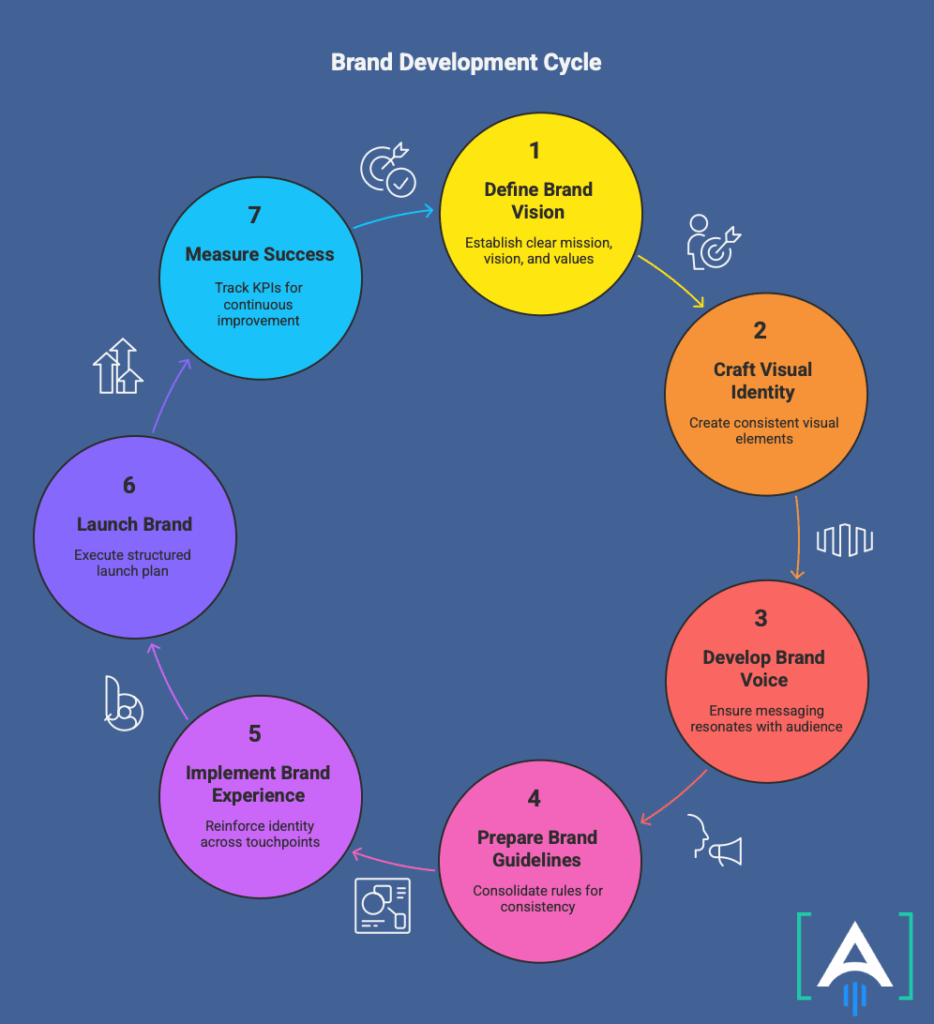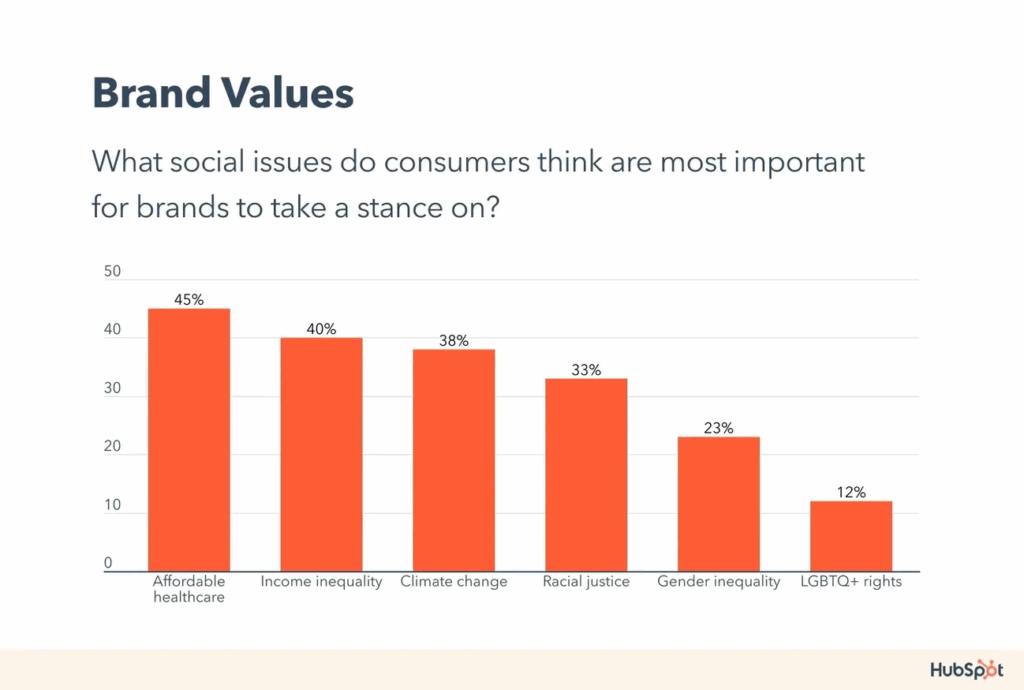A strong brand launch strategy is essential to take a startup from stealth mode to market leadership in a short time.
The way you position, communicate, and activate your brand determines how quickly customers recognize and trust you.
A successful launch combines a structured brand development guide, a solid brand strategy framework, clear visual identity design, consistent brand voice development, brand experience design, and a practical brand guidelines template.
Startups often underestimate the power of planning. Many founders focus solely on product features and neglect brand perception. Yet research shows that companies with well-defined brands that pay attention to brand and customer loyalty grow their revenue 2.5 times faster. Establishing a strong foundation before launch ensures messaging, visuals, and customer experience align perfectly from day one.
Partnering with a branding agency can accelerate execution. Agencies provide strategy, design, and growth marketing expertise, ensuring fast and consistent rollout. In this article, we guide business owners and CEOs through a step-by-step approach to launching a brand effectively within 90 days.
Understanding The Startup Launch Landscape
A brand launch strategy starts with understanding the competitive environment. Startups face unique challenges: limited budgets, short timelines, and high market expectations. The speed at which your brand enters the market can define its trajectory.
According to CB Insights, 42% of startups fail because they do not adequately assess market demand, making insufficient market research a top reason for failure. Early recognition and trust are critical to success. Building awareness before the product launch ensures potential customers are prepared to engage.
Brand launches also benefit from pre-launch campaigns. Teasers, beta access, and early press mentions generate excitement. Companies like Dropbox and Airbnb gained early traction by carefully managing stealth mode announcements.
Using targeted messaging aligned with a brand strategy framework ensures clarity and consistency across every channel.

Step 1: Defining Your Brand Vision And Strategy
A startup cannot launch successfully without a clear brand development guide and brand strategy framework. These documents define who you are, what problem you solve, and why customers should care.
Key steps include:
- Define your mission, vision, and values clearly
- Identify target audience personas and their specific needs
- Highlight differentiators and unique value propositions
Having these elements ensures all marketing, design, and operational decisions reinforce the same brand story. Airbnb in its early days focused on trust, community, and simplicity. This guiding vision made it easier to scale globally while remaining consistent. A clear strategy also informs your brand launch strategy and aligns your teams for execution.
Step 2: Crafting Visual Identity Design
Visual consistency is essential for recognition and credibility. A strong visual identity design helps potential customers recognize and remember your brand.
Your visual identity should include:
- Logo variations and proper usage rules
- Color palette for digital and print
- Typography and hierarchy standards
- Iconography and illustration guidelines
- Photography and imagery styles
Famous examples include Slack, whose color palette, logo, and illustration style create a cohesive and friendly appearance across platforms. Using a structured brand guidelines template ensures designers and marketers apply visuals consistently, even under tight timelines.
Step 3: Developing Brand Voice And Messaging
A consistent brand voice development ensures your messaging resonates with your audience. Your voice communicates personality and values through copy, social media, and customer support.
To develop a scalable voice:
- Define tone and key messaging pillars
- Create sample templates for emails, social posts, and support scripts
- Train internal teams to apply voice consistently
- Audit content regularly to maintain alignment
Mailchimp’s approachable and human-centered voice is a prime example. Every interaction, from emails to social campaigns, reflects the same tone. Startups benefit from clear voice rules as they scale marketing efforts quickly.
Step 4: Preparing Brand Guidelines Template
Before launch, a brand guidelines template ensures consistency across channels. It consolidates rules for visuals, voice, and messaging in a single reference document.
A robust template includes:
- Logo usage rules
- Typography and color standards
- Voice and tone guidelines
- Marketing and product templates
- Photography and illustration examples
Having this reference reduces errors, accelerates content production, and keeps early employees aligned. Brands like Spotify executed rebranding with minimal confusion by strictly following internal guidelines.
Step 5: Implementing Brand Experience Design
Brand experience design ensures every interaction reinforces your identity. From the website to support channels, every touchpoint should reflect your values and messaging.
Focus areas include:
- Website onboarding and product experience
- Customer support and communication scripts
- Social media engagement and campaigns
- Packaging, merchandising, or app interface
Companies investing in experience see measurable results. For example, Tesla maintains consistency across physical stores, digital channels, and product experience. Customers trust the brand because every touchpoint aligns with expectations.
Step 6: Launching And Activating The Brand
Executing a brand launch strategy requires a structured timeline. Planning is key to creating momentum and gaining early traction.
90-Day Launch Plan:
- Pre-launch awareness: teasers, beta invitations, and press outreach
- Official launch: announce via multiple channels simultaneously
- Early adopter engagement: collect feedback and optimize messaging
- Post-launch refinement: adjust campaigns based on performance metrics
Companies like Notion and Stripe achieved rapid growth by carefully managing early communications and maintaining consistent visuals, voice, and experience across channels.
Step 7: Measuring Success And Iterating
A brand launch strategy must include KPIs to track impact. Metrics guide adjustments and ensure continuous improvement.
Track these key indicators:
- Brand awareness and reach
- Engagement and interaction rates
- Conversion rates and early adoption
- Retention and referral metrics
Iterating based on data ensures campaigns remain aligned with market needs. HubSpot reports that businesses that track and optimize their initial branding efforts experience faster growth and achieve a stronger product-market fit.

Scaling And Maintaining Momentum
After a successful brand launch, the focus shifts to sustaining growth and ensuring long-term relevance. Brand activation does not stop once the initial campaigns are complete. Continuous efforts in marketing, content creation, and customer engagement are essential to maintain visibility and reinforce trust.
Brands that actively nurture their presence post-launch are more likely to achieve lasting market leadership and customer loyalty.
Steps to maintain momentum include:
- Conduct Regular Audits for Visual and Messaging Consistency: Check that all marketing materials, digital assets, and communication channels follow your established brand guidelines. Inconsistent visuals or messaging can confuse customers and dilute brand recognition.
- Expand Into New Channels While Maintaining Identity: Explore new marketing platforms, partnerships, or regions carefully, ensuring that your core brand identity and voice remain intact. For example, brands like Airbnb carefully expand into international markets without altering their recognizable tone or design style.
- Leverage Customer Feedback to Refine Touchpoints: Actively collect and analyze customer feedback to identify friction points or areas for improvement. Adjusting messaging, support processes, and product presentation based on real data strengthens loyalty and encourages repeat engagement.
Scaling without losing consistency is especially critical for startups. Rapid growth often strains internal teams and processes. By enforcing guidelines, training staff, and monitoring performance, startups can maintain credibility and protect brand equity even as they grow quickly.
Founder-Focused Rapid Growth Tactics
For startup founders, speed is a decisive factor. A fast brand launch strategy is essential, but rapid execution must not compromise brand integrity.
Founders need to balance urgency with consistency to achieve measurable results in short timeframes.
Key tactics for rapid growth include:
- Launch Minimal Viable Campaigns and Test Early: Deploy small-scale campaigns to gauge audience interest and gather early feedback. This approach allows iterative improvements before committing significant resources.
- Collect Metrics from First Interactions and Iterate Quickly: Track KPIs such as engagement, conversions, and retention from the very first launch activities. Data-driven adjustments can optimize results and prevent wasted efforts.
- Use AI Tools to Automate Templates and Content While Following Guidelines: Leveraging automation ensures content is produced efficiently and adheres to established brand standards, reducing errors and maintaining consistency across multiple channels.
Fast-scaling examples highlight the effectiveness of this approach. Stripe, for instance, launched globally with minimal resources but rapidly gained traction by emphasizing exceptional early customer experiences and maintaining clear, consistent messaging.
Similarly, Notion used focused MVP campaigns and feedback loops to iterate quickly and expand while keeping the brand voice uniform.
These strategies demonstrate that founders can achieve rapid market adoption without sacrificing long-term brand integrity.
Conclusion
A well-planned brand launch strategy turns startups into recognized market leaders in 90 days. Combining a brand development guide, brand strategy framework, visual identity design, brand voice development, brand experience design, and brand guidelines template ensures every touchpoint is intentional.
Partnering with a professional branding agency like [A] Growth Agency accelerates execution. Agencies provide strategy, design, and growth marketing support, helping business owners launch consistently and efficiently.
![[A] Growth Agency](https://src.azariangrowthagency.com/wp-content/uploads/2025/11/image-40-1024x487.png)
An effective partnership ensures your brand grows rapidly while maintaining credibility and trust.
Let us transform your startup into a market leader through a structured launch strategy that delivers measurable results. Partner with us and make your 90-day launch a success.

